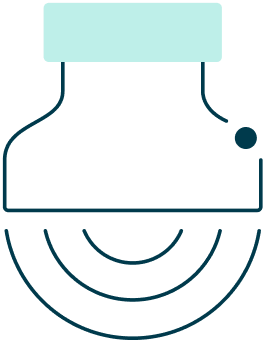Radiofrequency
What is radiofrequency for pain
Radiofrequency is an analgesic treatment that allows to treat pain by applying an electric current that generates different effects depending on the type of radiofrequency we are using, depending on the patient’s pathology.
Below we will see the types and for which pathologies it is indicated in each case.

Types of radiofrequency for pain treatment
Conventional radiofrequency
It is an ablative treatment in which a continuous voltage is applied through one or more needles. These needles are placed around a nerve and by applying current to them, they will reach a temperature that will allow the painful impulse to be interrupted. It is usually applied exclusively to sensitive nerves.
Next we will see for which pathologies it is indicated:
- Lumbar pain due to facet syndrome
- Sacroiliac pain
- Cervical pain due to facet syndrome
- Knee pain due to osteoarthritis
- Post-surgical knee pain
- Hip pain due to osteoarthritis
- Post-surgical hip pain
- Shoulder pain due to osteoarthritis
- Adhesive shoulder capsulitis
- Facial pain due to neuralgia
- Complex regional pain syndrome
Pulsed radiofrequency
It is a neuromodulator treatment that uses a voltage applied discontinuously through one or more needles. These needles are placed around a nerve and, applying current to them, will reach a temperature that will allow the painful impulse to be modulated and reduced. Unlike the previous one, this treatment is indicated to treat altered structures, in which there are neuropathic alterations (lesions of the nervous system), or those that are mixed structures (with motor component) that should not be treated by ablative methods since they would lead to a loss of function.
Below, we indicate for which pathologies it would be indicated:
- Radicular pain / Sciatica
- Shoulder pain due to tendinitis
- Meralgia paresthetica pain
- Post-surgical pain after inguinal hernia and lung surgery
- Elbow pain
- Complex regional pain syndrome
- Ankle pain
- Knee pain
- Facial neuralgia
- Arnold’s neuralgia
Cooled radiofrequency or cooled radiofrequency
It is a variant of ablative treatment in which a cooling technology is applied after the radiofrequency. In this way we will generate a larger treatment area and we will be more effective. This technology is applied in those body locations where the intervention is complex due to the anatomical variability of the nerves.
The treatment is similar to conventional radiofrequency and will be of great help when the nerve is difficult to locate.
Below, we indicate for which pathologies it would be indicated:
The procedure
In order to correctly apply this treatment and obtain the effectiveness it can provide, a correct diagnosis and evaluation of the patient is essential. The doctor will ask specific questions that, together with the physical examination and evaluation of the complementary tests, will allow a more precise determination of the cause or causes of the pain.
- It does not require hospitalization in most cases.
- In some cases, conscious sedation may be used.
- We could accompany the treatment with local analgesics or corticoids.
Frequently asked questions about radiofrequency treatment
Does radiofrequency help with pain?
Yes, radiofrequency is a very effective technique in pain medicine. It is used to treat chronic pain, especially that of neuropathic (nervous) origin and that coming from the joints, such as low back pain, sciatica or shoulder osteoarthritis.
How is radiofrequency used to treat spinal joint pain?
It is used to perform a procedure called rhizotomy or facet denervation. The facet joints of the spine can wear out and cause chronic low back pain. Radiofrequency is applied to the small nerves (medial branches) that transmit pain from these joints, effectively blocking the painful signal.
Is radiofrequency painful?
No, the procedure is not painful. It is performed under local anesthesia in the skin and deep tissues. You may feel slight discomfort or pressure when the needle is inserted, but the treatment itself does not hurt. It is normal to feel mild pain in the treated area during the following days, which is relieved with common painkillers.
Am I a good candidate for this treatment?
This procedure is ideal for you if you suffer from chronic (more than 6 months) localized pain, such as lumbar pain due to facet arthrosis, certain neuralgias or sciatica that does not improve. A medical specialist will evaluate your case to confirm if radiofrequency is the best option for you.
What results can I expect and how long will it take?
The goal is a significant and lasting reduction of your pain. You will begin to notice considerable relief about 3 weeks after treatment. This relief will allow you to reduce your medication, move more freely and regain your quality of life.
What care should I take after treatment?
Recovery is very fast. We recommend a relative rest of 24-48 hours, avoiding physical efforts. You will be able to resume your daily activities progressively very soon. We will give you all the indications to ensure a comfortable and successful recovery.
Efficiency
According to standard protocols accepted by the industry, a substantial improvement in pain (in most cases greater than 70%) should be noted 3-5 weeks after treatment.
It is advisable to combine this treatment with functional recovery guidelines to maximize results and achieve a prolonged duration of more than 6 months.
70%Generally greater than

Our customers say
Insurance companies
Ask your MIVI centre for information on the agreements with insurance companies.










